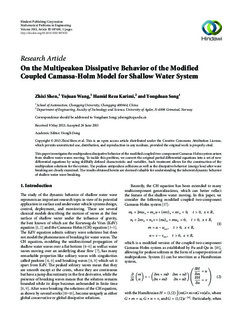| dc.contributor.author | Shen, Zhixi | |
| dc.contributor.author | Wang, Yujuan | |
| dc.contributor.author | Karimi, Hamid Reza | |
| dc.contributor.author | Song, Yongduan | |
| dc.date.accessioned | 2014-03-24T09:36:14Z | |
| dc.date.available | 2014-03-24T09:36:14Z | |
| dc.date.issued | 2013 | |
| dc.identifier.citation | Shen, Z., Wang, Y., Karimi, H. R., & Song, Y. (2013). On the multipeakon dissipative behavior of the modified coupled camassa-holm model for shallow water system. Mathematical Problems in Engineering, 2013. doi: 10.1155/2013/107450 | nb_NO |
| dc.identifier.issn | 1024-123X | |
| dc.identifier.uri | http://hdl.handle.net/11250/192860 | |
| dc.description | Published version of an article in the journal: Mathematical Problems in Engineering. Also available from the publisher at: http://dx.doi.org/10.1155/2013/107450 Open Access | nb_NO |
| dc.description.abstract | This paper investigates the multipeakon dissipative behavior of the modified coupled two-component Camassa-Holm system arisen from shallow water waves moving. To tackle this problem, we convert the original partial differential equations into a set of new differential equations by using skillfully defined characteristic and variables. Such treatment allows for the construction of the multipeakon solutions for the system. The peakon-antipeakon collisions as well as the dissipative behavior (energy loss) after wave breaking are closely examined. The results obtained herein are deemed valuable for understanding the inherent dynamic behavior of shallow water wave breaking. | nb_NO |
| dc.language.iso | eng | nb_NO |
| dc.publisher | Hindawi Publishing Corporation | nb_NO |
| dc.subject | VDP::Matematikk og Naturvitenskap: 400::Matematikk: 410::Analyse: 411 | nb_NO |
| dc.title | On the multipeakon dissipative behavior of the modified coupled camassa-holm model for shallow water system | nb_NO |
| dc.type | Journal article | nb_NO |
| dc.type | Peer reviewed | nb_NO |
| dc.source.pagenumber | 1-11 | nb_NO |
| dc.source.journal | Mathematical Problems in Engineering | nb_NO |
| dc.identifier.doi | 10.1155/2013/107450 | |
